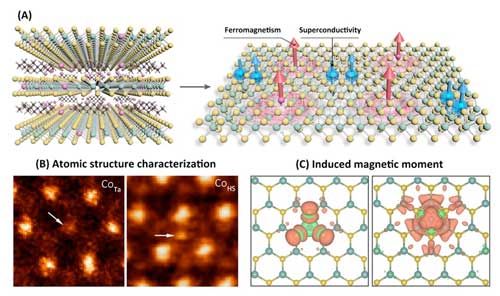| Jul 30, 2020 | |
Incorporating ferromagnetism and superconductivity together in a single layer of molecular superlattice(Nanowerk News) National University of Singapore (NUS) scientists have demonstrated an interlayer-space confined chemical design (ICCD) method for the synthesis of single-atom doped tantalum disulfide (TaS2) molecular superlattice, where ferromagnetism was successfully introduced in the superconducting TaS2 layers (Advanced Materials, "Imprinting ferromagnetism and superconductivity in single atomic layers of molecular superlattices"). |
|
| The interplay between superconductivity and ferromagnetism creates numerous exotic physical phenomena, which can be harnessed for next generation device applications. The integration of these two competing phases is usually achieved by vertically stacking superconductor and ferromagnetic layers one after another. Controllable synthesis of hybrid atomic layers which accommodate both superconductivity and ferromagnetism remain a considerable challenge. | |
| A research team led by Prof LU Jiong from the Department of Chemistry, NUS has demonstrated that the incorporation of isolated cobalt (Co) atoms into superconducting TaS2 layers can induce local magnetic moments and ferromagnetic coupling. This creates a material with ferromagnetic and superconducting domains within a single atomic layer. | |
 |
|
| Figure (A) provides a schematic illustration of the interlayer-space confined chemical design (ICCD) method for the synthesis of tantalum disulfide (TaS2) molecular superlattice with the superconducting regions and ferromagnetic regions in a single atomic layer. Figure (B) includes the high-angle annular dark-field scanning transmission electron microscopy (HAADF-STEM) images showing the substituted Co atom (CoTa) and hollow-site Co atom (CoHS) within the TaS2 material. Figure (C) is the spin density plots of the TaS2 monolayer with CoTa (left) and CoHS (right) showing the introduction of ferromagnetism into the TaS2 material. [© Advanced Materials] (click on image to enlarge) | |
| In comparison with conventional vertically stacked structures, integrating these two competing phases into a single layer not only offers improved flexibility in device design and fabrication, it also opens up new potential applications. | |
| Prof Lu’s team developed this new approach, called ICCD, for the simultaneous intercalation and chemical modification of bulk 2H-TaS2, where ferromagnetism is introduced into the TaS2 material while retaining its superconductivity properties (Figure A). | |
| Inserting tetrabutylammonium molecules into the space between layers of TaS2 opens up the spacing between them and allows Co2+ ions to be integrated into the structure. | |
| The researchers found that the Co2+ ions either replaced the tantalum (Ta) atom or got adsorbed at a hollow site (between two Ta atoms) (Figure B). This ICCD strategy can potentially be applied to various metal ions, enabling a versatile and scalable synthesis of a class of molecular superlattices with tailored properties via interlayer modification. | |
| The team’s experimental results, together with theoretical calculations carried out by Prof Yuanping FENG’s group from the Department of Physics, NUS show that the orbital-selected p–d hybridisation between Co and their neighbouring Ta and S atoms induces local magnetic moments and ferromagnetic coupling (Figure C), presumably mediated through a mechanism known as the Ruderman-Kittel-Kasuya-Yosida exchange interaction. | |
| Prof Lu said, “We envisage that our findings of the interlayer-space confined chemical design will provide a new chemical route to engineer artificial molecular superlattice of layered materials with exotic and antagonistic properties for desired functionalities.” |
| Source: National University of Singapore | |
|
Subscribe to a free copy of one of our daily Nanowerk Newsletter Email Digests with a compilation of all of the day's news. |
